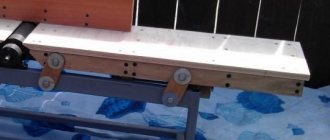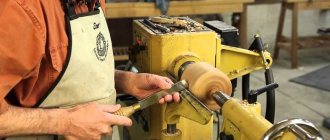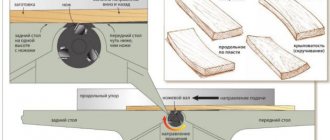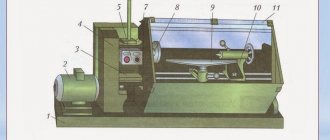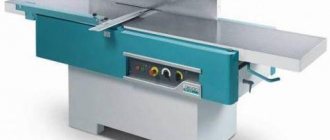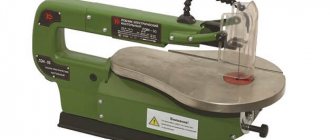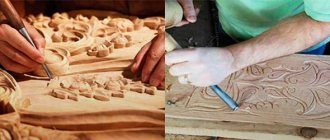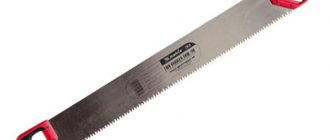Purpose of a thickness planer for wood
A thicknessing machine is needed for the production of wooden products from boards, beams and other raw materials made of wood. This tool is designed to give the workpiece the required thickness. It allows you to make the surfaces of the wood parallel. After processing the workpieces with a thicknesser, you can obtain parts with smooth edges and the desired cross-section.
Thicknessing machines have the following characteristics:
- planing depth: 5 mm;
- weight: 25-30 kg;
- power consumption: more than 900 W;
- caliber (maximum planing width and thickness of the workpiece): 330 mm;
- blade shaft rotation speed: 8-10 thousand rpm;
- planing depth: up to 3.2 mm.
A thickness planer differs from a planer and planer in its functional features. A thicknesser is capable of making the second side of a wooden piece parallel to the first. A planing and planing tool allows you to remove all unevenness and roughness from the board. He cannot calibrate a wood product by thickness.
In industry, thicknessing and planing machines are used together. Using these tools, you can initially level the base surface of the workpiece and then calibrate it to the desired thickness. Modern enterprises use thickness planers. These combination tools allow you to perform a full cycle of wood processing.
Design and principle of operation of a thickness planer
The device of a thickness planer consists of the following mechanisms:
- Knife shaft. This element is located on the electric surface planer motor. Cutting knives in the shape of spirals, characterized by a low noise level, are fixed on it.
- Desktop. It is a horizontal surface designed to form the depth of cut. This element of the machine is made of wood and carefully polished. The length of the work table is 0.1 m.
- The bed is a cast iron base on which the work table and knife shafts are mounted. This mechanism ensures the stability of the machine. The bed is made of cast iron and is connected to the work table using clamps - tools for fixing parts.
- Drive unit. This mechanism consists of an electric motor, a pulley, belts and drive chains. The drives of powerful machines are equipped with two electric motors.
- Screw device. It is designed to determine the caliber of the planing tool. With its help you can set the cutting thickness.
- Rollers. They are part of the feed mechanism of the machine and are divided into 2 pairs. The first pair is placed above the path of the board. The second pair is located parallel to the first. The rollers are driven by an electric motor.
- Suction system. It is designed to remove sawdust and tiny wood dust generated during planing of bars. A vacuum cleaner can also be used as a suction system.
- Top knot. Consists of rear and front rollers. This mechanism improves grip on the workpiece being processed. It allows you to control the direction of movement of the bar. The rear shaft of the upper unit has a grooved surface. The front shaft has straight sides.
- Bottom node. Used to feed the workpiece onto the work table.
- Clamping unit. Necessary for maintaining optimal board temperature during planing. It consists of spring mechanisms and claw grips.
- Guide slides. Designed to move the machine and its main components in several directions.
The operating principle of a thickness planer is to process wood using the flat planing method. The processed bars are installed under the cutting knives and fixed on the work table. By applying the knife blades to the surface of the wood, the workpieces are calibrated. As a result, the part takes on the desired shape.
Modern models of machines are equipped with an automatic workpiece feeding system. It is represented by rollers that press the bars against a rotating shaft.
If there are automatic feeding mechanisms, you can adjust the pulling speed and the angle of inclination of wooden products. This allows you to improve the quality of processing parts with non-parallel edges. Using these mechanisms, lumber up to 1 m wide can be cut. The cutting depth is on average 155 mm. Thicknessing machines with automatic mechanisms are durable and have a high level of productivity.
Sawing wood
Sawing is the cutting of wood with saws to divide it into parts (blanks and parts). When sawing, a cut is formed, from which part of the wood comes out in the form of sawdust. A saw is a steel strip or tape with a number of teeth (cutters). The teeth have the following parameters (Fig. 4, a): the distance between two adjacent vertices is called the step , and the distance between the base and the vertex is the tooth height . A cavity (sinus) is used to remove sawdust formed during the sawing process. Each saw tooth has three cutting edges: one short front and two side ones.
transverse sawing (across the wood fibers), longitudinal (along the wood fibers) and mixed (curvilinear or at an angle of less than 90° to the wood fibers). Therefore, the saw teeth have different shapes (Fig. 4, b). For longitudinal sawing, saws with an oblique (inclined) tooth are used, for transverse sawing - with a tooth in the form of an isosceles or equilateral triangle, for mixed sawing (along curved outlines) - with a tooth in the form of a right triangle.
Rice. 4. Saw tooth elements (a) and saw tooth angles (b) : 1 – for longitudinal; 2 – for mixed; 3 – for cross cutting
Hand saws vary in shape and purpose. There are saws for straight and curved sawing, for sawing thin and thick materials, through and non-through cuts (Fig. 5).
Rice. 5. Hand saws : a – bow saw; b – hacksaws; c – jigsaw; g – obushkovaya; d – reward; 1 – saw blade; 2 – bowstring; 3 – stand
The bow saw (Fig. 5, a) is designed for longitudinal and transverse sawing of wood. The saw blade of this tool is fixed at both ends in the machine (beam) and tensioned, due to which it is longer and thinner than that of a hacksaw. During operation of a bow saw, its blade does not bend, the cut is thinner and cleaner, and therefore the size of the workpiece will be more accurate. This saw allows you to make movements at the full span of your arm, which greatly reduces the time required. Depending on their purpose, bow saws can have different blade widths and tooth pitches.
Hacksaws (Fig. 5, b, d) are wide, narrow and with a back. A wide hacksaw is used for manual sawing of wood and wood materials when performing carpentry and carpentry work. Hacksaws can be used for longitudinal, transverse and mixed sawing. Narrow hacksaws are used for curved sawing and sawing thin materials.
Backed hacksaws (Fig. 5, d) have fine teeth and a thin blade, the upper part of which is reinforced with a steel strip (backed) to give the blade rigidity. These hacksaws are designed for delicate work that requires precise and even cuts, for example, making tenon joints.
Reinforcements (Fig. 5, e) are intended for blind sawing of grooves, as well as for cutting veneer and thin plywood.
Jigsaws (Fig. 5, c) are used for sawing small parts from thin boards and plywood, curved sawing with sharp bends, and also for cutting holes in the central parts of boards.
To prevent the saw blade from getting pinched in the cut, the teeth must be set apart.
The setting of the saw teeth is that they are bent one by one: the even teeth in one direction, and the odd teeth in the other. When spreading the teeth, you need to bend not the entire tooth to the side, but only its upper part at a height of approximately 2/3 from the base. When sawing hardwood, the teeth are set apart by 0.25...0.5 mm to the side, and softwood - by 0.5...0.7 mm. The teeth of a hand saw are set as follows. The saw blade is tightly clamped in a vice, and then the teeth are bent alternately in one direction or the other by setting them. You need to spread the saw teeth evenly, without much effort or sudden movements, otherwise the tooth can be broken.
During the sawing process, the teeth become dull. To restore the cutting ability of the teeth, they are sharpened with files. Sharpening should be done evenly, without strong pressure (as this can cause the saw to overheat), so that there are no burrs. Cross-cut saws have an oblique sharpening, so when sharpening the file, the file is held at an angle of 60...70º. Having sharpened one tooth on one side, sharpen the missing teeth on the other side.
They work with a hacksaw as follows. The marked workpiece is placed on a workbench or table so that the sawn section hangs from
him. They press the workpiece with their left hand, and with their right hand they make a cut - several short movements of the saw towards themselves. After sawing, the hacksaw is moved along its entire length, aligning it with the marking line of the cut. There should be no physical effort when sawing correctly: only a slight, even pressure on the hacksaw during smooth movements will ensure an even cut. At the end of sawing, the pressure on the saw is eased so as not to break off the wood fibers when the saw exits. It is best to position the workpiece so that the piece to be sawn is on the left side: when sawing is completed, the free left hand will more easily hold the unnecessary piece and prevent it from falling on your feet.
For precise sawing of bars and boards at certain angles (90°, 45°, 60°, etc.), miter boxes are used (Fig. 6). The miter box has a grooved shape. It consists of a bottom and two sides, between which the workpiece to be cut is clamped. The sidewalls have cuts made at the desired angle. The saw blade is inserted into these cuts, after which sawing is carried out at the desired angle.
Rice. 6. Sawing in a miter box : 1 – bottom of the miter box; 2 – sidewall; 3 – workpiece; 4 – saw
Types of thicknessing machines
Based on the number of surfaces processed, the following types of thicknessing machines are distinguished:
- One-sided. They are small in size and are used in home workshops. These tools are capable of planing only 1 side of the part. Single-sided machines most often process the upper surfaces of lumber.
- Double sided. They belong to the class of professional equipment and are used in small production workshops. With these tools you can plane both the top and bottom sides of the timber at the same time. The advantages of double-sided machines are high power and speed of processing wood parts.
- Multilateral. These tools are used in large industries. They are capable of simultaneously processing at least 3 sides of the bar, giving it a certain shape. Multilateral surface thicknessers are characterized by large dimensions and high performance. They require careful care and repair.
Based on their design features, thicknessers are divided into:
- Mobile. They are distinguished by their low weight and size. Therefore, they can be moved over long distances. The advantage of mobile machines is ease of operation.
- Stationary. They are heavy and large in size. Stationary devices are used at industrial prices. They cannot be moved to another location in a short period of time. A feature of stationary machines is their productivity. Unlike surface planer tools, they are capable of quickly processing large workpieces with a large number of edges. The disadvantage of stationary devices is the complexity of maintenance and repair.
There are also separate classifications of thicknessing machines based on the speed of rotation of the knife shaft, the number of removable blades, and energy efficiency.
Thicknessers for home use
Thicknessing machines for household purposes have the following features:
- Compactness. The main components of the planing tool are small in size, so they can be placed in small workshops.
- Low power of the electric motor. For this reason, household machines cannot be used for processing large parts with a cutting depth of more than 1.5 mm.
- Light weight equipment. Household thicknessers can be quickly moved and installed on other work surfaces.
- Economical. Thicknessing machines for home workshops have a budget price. Their average cost is 25 thousand rubles.
Household surface thicknessers are equipped with parts feeding mechanisms. They are used for shallow cuts on wooden surfaces. The advantage of planing tools for home workshops is their ease of use. They do not require careful maintenance or repair.
Industrial thicknessers
Industrial thicknessing CNC machines have the following features:
- Maximum power. Industrial tools are capable of planing large quantities of lumber.
- High processing speed. Machines for industrial production make 10 thousand revolutions per minute.
- High planing depth. Industrial tools can process parts requiring cutting depths greater than 1.5 mm.
Industrial machines operate on the principle of a planer. Removable blades are located on both sides of the cutter shaft. Production thicknessers are equipped with a double stand, a rotating drum and a cooling system. A specialist can independently adjust the cutting depth of the tool using built-in controllers.
Areas of use
Thicknessing machines, in one form or another, are present in every large woodworking enterprise and in any small workshop. Using this installation, you can solve the following necessary tasks:
- make the workpieces as smooth and patterned as possible;
- level floorboards or wall panels;
- level the surface of any wood product;
- carry out planar processing of the product.
Video - Choosing a thickness planer for a garage workshop
How to choose
When purchasing a machine for your home workshop, it is recommended to consider the following factors:
- Budget. The cheapest models of household surface planers cost 19,000 rubles. Budget models of machines can only be used for light loads and small volumes of work.
- Place for the machine. Planing tools for the home must be located in a room with an area of at least 4 m2. It is necessary to provide access to the device from all sides and make room for feeding lumber. It is important that the mini thickness planer is located on a flat surface and not exposed to vibrations.
- Technical specifications. They characterize the capabilities of planing equipment. The main technical parameters of thicknessing machines are electric motor power, weight, dimensions, cutting depth and rotation speed of the knife shafts. These indicators affect the productivity of the machine, the quality of wood processing and the difficulty of transporting equipment.
- Machine components. It is recommended to purchase tools with a digital display, polymer feed rollers, handles for transporting planing equipment and a sawdust removal system.
The most popular among buyers are machines made in China, Japan and the USA. The largest manufacturers of surface thicknessers are JET, Makita, Sturm, Patriot and Metabo. When purchasing a planing machine, it is recommended to check the quality of its manufacture. It should not have scratches, dents or other external defects. It is important that the shafts and removable blades are tightly secured.
Working on thicknessing machines
To plan wood using a surface planer, it is necessary to place the workpiece on the work table at a right angle relative to the knife shaft. When feeding manually, you need to hold the block on both sides with your hands and smoothly feed it towards the blades. The processed part of the workpiece must be removed and fed to the knives with the other end. These actions must be carried out when processing all edges of the bar.
When working with thicknessing machines for wood, you must follow safety precautions:
- Carefully feed the workpieces. The boards quickly enter the compartment with high clamping force. It is important that your hands do not get caught in the clamping unit. Otherwise, the operator may be injured.
- Use support bars when planing short workpieces. Otherwise, the workpieces may fall out of the machine, causing injury to the operator.
- Take the correct posture. Before working on a thickness planer, you must stand to the side of it. This will avoid injury when feeding and receiving boards. When working in this position, it is recommended to use extension tables and rollers. They will allow you to easily feed and accept long boards.
- Do not remove the wood cover to clean sawdust from the workbench. This may cause injury. Industrial vacuum cleaners must be used for cleaning.
- Control the size of processed workpieces. When feeding parts with a protruding edge, the bars may become deformed when they come into contact with the rotating shaft.
After each processing session, it is necessary to check the condition of the planing apparatus. It is necessary to regularly lubricate the working elements of the machine and replace the removable blades on the knife shaft.
Purpose of a surface planer
A marking thicknesser is a tool that is designed to quickly apply marking lines to the surface of the workpiece. The drawn line runs parallel to the selected reference line, usually parallel to the edge of the part. Marking lines can be either straight or curved. Using a thicknesser, you can take a dimension from a drawing or sample and transfer it to the workpiece.
The simplest model consists of a body and a rail in which a marking device is secured with a screw. And from this moment on, differences in the design begin to appear: the rail can be stationary relative to the body, or it can be movable. The rail can be single or paired. The cross-section of the rack is square or rectangular, this prevents it from turning during operation. Cutting, scratching or drawing devices can be used as an application tool. Cutting and scratching tools create a mark on the surface of the part, which makes cutting along the mark easier.
The thicknesser works very simply. For example, the task is to saw off exactly 3 cm from the edge of the board in order to obtain the desired size of the workpiece. The distance between the block and the applying tool is set to 3 cm, the block is pressed against the edge of the board. The tool moves along the board and the marking is ready!
